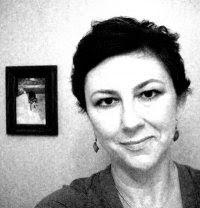Chiaroscuro refers to the gradual shift from light to dark as is falls across a curved surface. It is a great way to build solid, believable forms. Keep in mind, you need an identifiable light source; one in the front, slightly above and to one side is best. If the light is too harsh, soften it by placing a white sheet of paper between the model and the light---or bounce the light off the white paper or board.
We will use grey Canson paper, black conté and white conté for this exercise.
 First, as few words about value: Value is the relative lightness or darkness of an object or space
First, as few words about value: Value is the relative lightness or darkness of an object or space
Value is relative to three things:
1. local value (the value of something in even lighting conditions)
2. value of surrounding area
3. amount of illumination
When creating a drawing using chiaroscuro, we look for six categories of light:
 Because we are using grey paper, one of the categories will be the local value of the paper.
Because we are using grey paper, one of the categories will be the local value of the paper.
We will shade with the black for shades darker than the paper, and heighten (lighten with white) for the areas lighter than the paper.

Left: Begin by lightly sketching a gesture drawing of the general dimensions of the head, including the shoulders. Check you proportions now. You are using only your black conte.
Center: Find the major bones/structure of the face and lightly suggest shadows. No harsh lines or edges here….you’re still looking, measuring, checking proportions. Still using only black conte.
Right: Keep defining shadows, looking at structure. Start to build up darks. If you are using a stick of conte, snap it into a small section and use the side to build the planes of the face. Remember, you are only shading the areas darker than the gray of your paper.

Once the structure is “set” and you are satisfied with the likeness, push the values and work on edge quality. Soften edges that you want to fade out, and emphasize edges that are hard planes (though you won’t find many of those). If you can’t see details, don’t include them. Draw what you see.
 The last step is to add the highlights. It doesn’t take much in terms of highlights to enhance the roundness of the form. A common mistake is to add too many whites, and flatten the face, so use them sparingly.
The last step is to add the highlights. It doesn’t take much in terms of highlights to enhance the roundness of the form. A common mistake is to add too many whites, and flatten the face, so use them sparingly.
Reference: The Artist’s Complete Guide to Drawing the Head, William L. Maugham


No comments:
Post a Comment